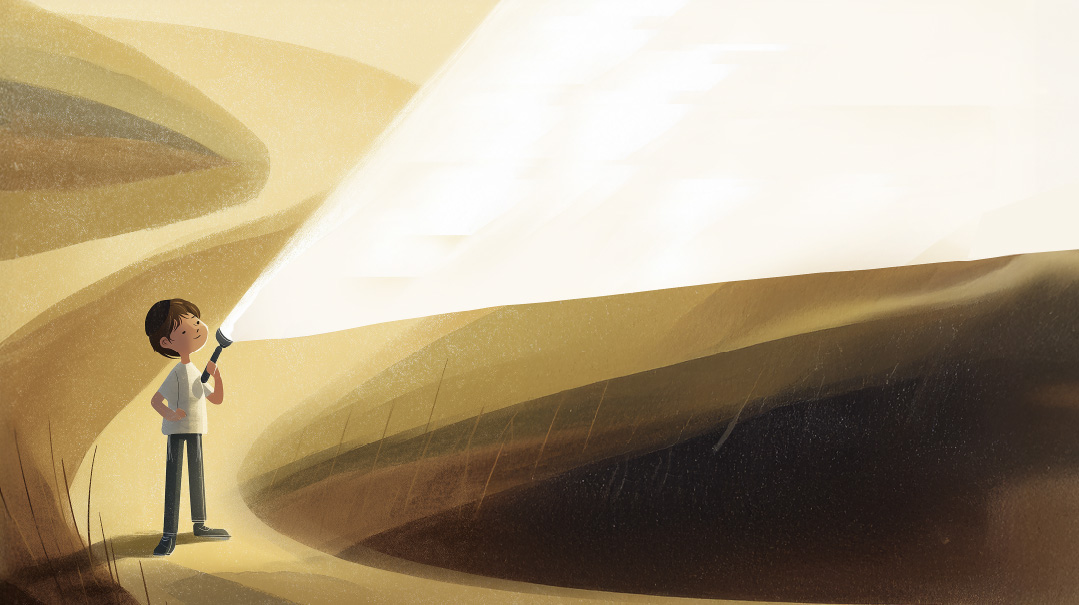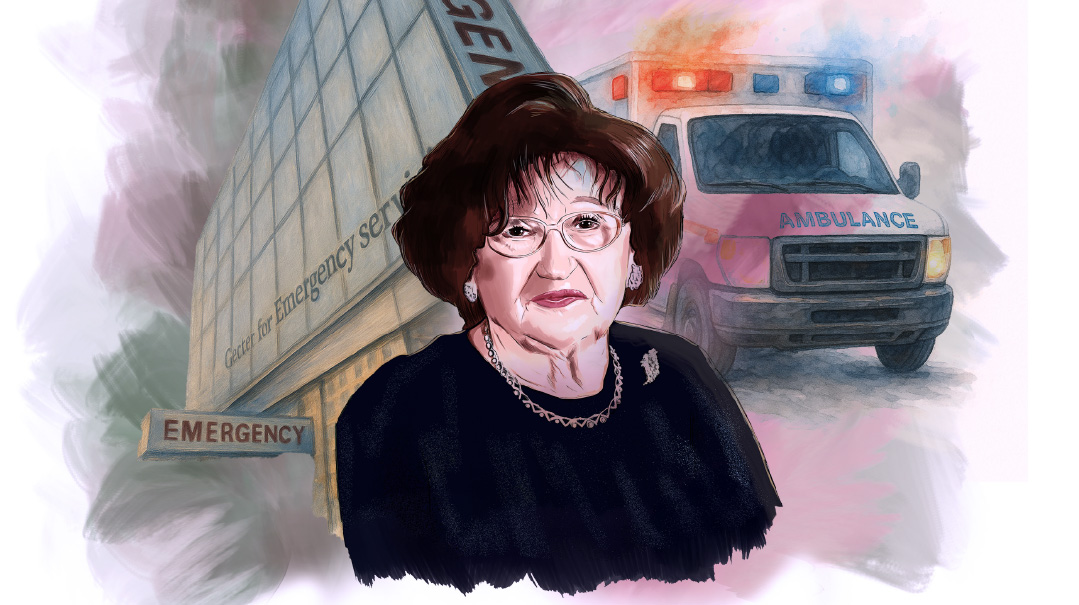Tour de Force
| September 5, 2023Mrs. Rochel Stefansky circles the world to help women connect

Mrs. Rochel Stefansky, of Manchester, UK, is the rebbetzin of a shul, as well as a popular high school halachah and Chumash teacher and mentor, and an adult educator. Oh, and a life coach and tour operator and guide. But what draws people to Rochel is more than the sum total of what she does and accomplishes. It’s who she is: someone very human, and very real, with a caring heart and a touch of funk and fun, who has absorbed Torah hashkafah into her own reality and lives with a love of Hashem and His people.
Our conversation in the Stefansky home doesn’t feel heavy — Rochel Stefansky is nothing if not a “normal” woman — but I’m fascinated as Rochel goes from one hashkafah idea to another, easily quoting Rav Mordechai Miller (of Gateshead Seminary fame), Rav Avigdor Miller, Rav Pesach Eliyahu Falk, Rabbi Zecharia Wallerstein zichronam livrachah, and other rabbanim.
I’m even more intrigued when she tells me how these ideas became the soundtrack of her life.
“Sixteen years ago, I was hurrying home from shul on Motzaei Yom Kippur when I was attacked by two dogs. I was thinking that I needed to get home and check how my daughter was, and before I knew it, I was on the floor, fighting off two dogs who were on top of me, out of control, panting and pawing, drooling and biting. When the ambulance arrived, the medical personnel discovered that although I was very bruised, the thick white jacket I had just put on had saved me from an actual bite. But it was a horrendous trauma.
“The next day, people were calling my husband to find out how I was, and everyone was saying, ‘I hope you send her to therapy.’
“But I knew I didn’t need therapy. I’d recently prepared and given a women’s shiur for Yamim Noraim, and the theme was, “U’vechein tein pachdecha,” how we ask Hashem to place His fear on us, and how when we feel fear, it’s a gift, a tool to bring us closer to Hashem. It’s not sent to paralyze us. It’s sent to awaken us and enable us.
“I knew that the refuah was prepared for me before the trauma — I didn’t need therapy, I just really needed to sit and internalize the messages I’d taught. And it worked.”
This incident became a catalyst for Rochel’s increased interest in listening to shiurim. Not a music person, she used to listen to the radio often. Although she abstained while her kids were with her, whenever alone at home or driving, the radio was her companion of choice. “That year, I tried not to listen to the radio during Elul, until Yom Kippur. Then, when I was attacked on Motzaei Yom Kippur, I didn’t feel like it was right to go back to the radio. Soon afterward, my husband bought me an iPod. He took it to shul and downloaded shiurim onto it, somehow picking out Rabbi Wallerstein, and I was hooked.
“Now, I listen to shiurim the whole time. And when I realize how much goes into my brain from all these shiurim, even when I’m not fully focused, it scares me how much stuff would have gone in from the radio.”
Learning and Living It
Rochel grew up in postwar London, in the home of wonderful parents, both mechanchim, whose mission in life was to teach and uplift. When she got older, she attended Gateshead Seminary, which she credits with offering her a lot of her life’s ideals.
Today, she is married to Rabbi Elozor Stefansky, a noted talmid chacham and the rav of the Vine Street (or Romanisher) Shul, a longstanding makom tefillah in Manchester. Rochel acknowledges gratefully that her husband has been learning all through their married life, and she feels strongly that this ideal can only work if one recognizes and values the privilege and joy of a Torah lifestyle. “I told my daughters that if they were thinking of being moser nefesh so their husbands could learn, they should please not bother. If they realize the privilege, and want to enjoy it, gezunterheit,” she says.
“I’m not a martyr type,” she tells me. Looking at the elegantly dressed and fully made-up woman sitting across from me as we sip delicious fresh-brewed coffee, I believe it.
“Martyrs are very difficult for husbands and families to live with, because they need a lot of appreciation and validation,” she continues. “I’m a happy person, a person who takes care of herself.”
Mrs. Stefansky, who teaches in Manchester’s Bais Yaakov High School, has been teaching since she was 11, when her father asked her to help out with a class of little boys at the Sunday cheder he ran in London’s East End. She’s the kind of teacher who meets students from 36 years ago who tell her, “You were the only one who believed in me,” or “I stayed frum because of you.” Although Mrs. Stefansky has cut down her teaching days by now, she still defines herself as a teacher, and says she only plans to retire once she stops learning or stops caring.
Even though she’s a veteran, she’s open to change. In recent years, Rabbi Wallerstein’s influence has changed Mrs. Stefansky’s way of teaching completely. She teaches 11th-grade Chumash to a group in which some of the students may have been “put off” by the focus on textual learning. Mrs. Stefansky’s opinion is that if a girl still struggles to read and translate mefarshim by 11th grade, it’s best to leave textual skills to the side and focus more on the content.
“I switched to an approach I learned from Rabbi Wallerstein,” she explains. “I ask the girls how the Torah, which was given so many years ago, can still be relevant to 16-year-olds in 2023, post-Covid.
“And then, we show how every single pasuk is relevant and is speaking to us. Every single pasuk! We don’t move on until we understand what Hashem is saying to us, through the eyes of the mefarshim, and we’ve distilled a life lesson from it.”
Shabbos in the Kitchen
“If I were a man, I’d learn in a halachah kollel,” Rochel says brightly. “I love to follow the halachah topics in Inyan magazine. When I was in sem, Rav Falk would borrow my notebooks to use when he prepared his hilchos Shabbos books for print. There was no Wite-Out in those days, but I took notes (which the rav dictated) meticulously and still have those notebooks, rebound.”
For many years Rochel would teach women in the process of conversion, and as she taught hilchos Shabbos, she realized that as menus developed and our Shabbos meals became more sophisticated, people were at a loss for how to apply the halachos they’d learned in school or seminary. “People would approach me after a shiur and ask me how to heat up molten chocolate cakes for dessert on Friday night,” she says.
These questions led Rochel to develop a curriculum called, “Shabbos in the Kitchen.” The series of live and recorded classes and accompanying workbook span all stages of food preparation, from Friday night to Motzaei Shabbos.
We’re chatting in her own tastefully decorated black-and-white kitchen, with touches of red, and I can imagine Rochel preparing her own family’s meals with flair. “Hot cherries with ice cream,” she says, “hot chocolate cake with sauce. How can we serve them? You can do six melachos when making a salad if you don’t know what you’re doing: tochen, borer, m’abeid, mocheik, if it’s packaged lettuce, makeh b’patish, and shochet if you soak the lettuce and kill a fly. That’s six mitzvahs to get when you do it right.”
The professionally recorded course is available on Rochel’s website, but she also sends it out on a USB drive, because she has clients with no internet access whatsoever. “Shabbos is for everyone, and I’ve taught these halachos to rebbetzins and to barely religious women.
“If someone tells me that it’s too much for her to take on, I show her a tomato. During the week, you pull off the stalk, but on Shabbos, you have to pull the tomato off the stalk. If you can do that, you’ve begun keeping hilchos Shabbos, and one mitzvah will lead you to more.”
Mrs. Stefansky dictates notes on her course, like the real teacher she is, but she’s surprised when I ask if she gives tests. “Hashem tests us every week! Shabbos is the test!” And while women are concerned about finding out that they’ve been doing things wrong until now, she encourages them to stay positive. “One woman was 35 when she learned that she’d been nichshol for years. She’d been waiting till the light of the thermostat went off, and then she would open her oven and serve. She was so upset when I explained to her how the oven works. But I said, ‘Start now, and you’ll do it right for the next 80 years.’ ”
Around the World
How did a teacher in Manchester come to book flights and hotels and plan itineraries and menus for groups of eager, frum globetrotters? Travel with Rochel, TWR, Mrs. Stefansky’s travel business, takes groups to Poland, Gibraltar, Lizhensk, Budapest, Prague, Venice, and Morocco, and some leave-your-brains-at-home, fun destinations such as Malta and Norway. Her groups are known for their friendly feel and the food for the soul that Mrs. Stefansky provides.
“Obviously, I didn’t travel like this when my kids were young and I had a family to take care of,” she emphasizes. “The door to this wonderful part of my life opened when another door had just closed.” After years of running the annual shabbaton in the high school where she taught, there were some faculty shifts, and the job of running the shabbaton was given to someone else.
Shortly after, instead of moping in Manchester, she went to visit her daughter and son-in-law, who were doing kiruv in Berlin. She was chatting with a group of girls her daughter was involved with, and the conversation touched on the Holocaust and Poland.
“They begged me to take them there,” Rochel remembers. “I felt it would be extremely valuable for these girls and their Yiddishkeit, so when I got home, I made some phone calls to put funding together, then organized a trip.
“Friends in Manchester heard and said, ‘Why only for those girls? Take us!’ ” Both trips were successful, and when it was over, the Manchester contingent said, “Rochel, where are we going next?”
Currently, Rochel teaches only on Wednesday, Thursday, and Friday, leaving the beginning of the week available for planning tours and traveling. Some groups are for women only — “There are single and divorced women and also married women whose husbands don’t like to travel but are happy for them to get away. You don’t have to bring a friend, because our groups become friends,” she says — while others are for couples. “On the Poland trip, I don’t take men, because I do a lot of talking, with a lot of emotion. On the other trips, I let them know when I’m going to stop and give a talk, so they can wander away.”
Rochel isn’t a historian, and doesn’t claim to be one. While she knows a lot of the historical context of the places she visits and shares plenty of stories, her focus is on Torah hashkafah and emotion, awakening Jewish feeling and understanding, whether in teenagers or middle-aged women who may be more used to leaving the divrei Torah to the men than hearing pesukim quoted as they wander around a Moroccan souk.
Hidden Love
When visiting Holocaust sites, Rochel tries to convey to her groups the greatness of the Jewish spirit, such as the bitterly difficult halachic questions which were asked during those times, recorded in books like Rav Oshry’s Responsa from the Holocaust. “My heart breaks for Jews who visit these places without a religious, Torah hashkafah,” she tells me. “It must feel terrible to experience only the tragedy and horror, with no sense of Hashem’s love and our eternal mission. On my tours, I cannot offer all the answers, but I can offer love of Hashem and Hashem’s love for us.”
Rochel gets impassioned when talking about her many visits to the Zbylitowska Gora Forest in Tarnow, Poland, a mass gravesite for 7,000 Jews, including hundreds of children. Tarnow was a well-known prewar Jewish Polish community, brutally wiped out by the Nazis and their Polish lackeys. In 1942, the city’s 7,000 remaining Yidden, including 800 young children from a Jewish orphanage, were shot and buried in a mass grave. Eyewitnesses found by a Polish priest recalled the screams and cries, but on the official front, there was only silence and denial.
“When I first wanted to find the site, I had to mime shooting children to the villagers,” Rochel tells me. “Of course, most of them played totally dumb. But I found it. And in the middle of the forest, there was a sign about which flowers, animals, and birdlife could be found in the wooded areas, but no sign about the mass graves of hundreds of Jewish children.”
It was sickening, though not surprising, and Mrs. Stefansky went to battle, via the Polish consul in England. She shows me the email correspondence back and forth, and shares the recent developments, in which the Polish government has agreed to her request to mark the site of the shooting with a memorial plaque. She’s asked Rabbi Jonathan Guttentag to prepare the text, and hopes to attend a memorial service for the kedoshim when it’s unveiled.
When I ask Rochel how she creates relevance and connection for women and girls who don’t have roots in Eastern Europe, or the younger generation who don’t know of any relatives among the Yidden of Lodz, Cracow, Warsaw, or Auschwitz, she looks a bit puzzled. “Klal Yisrael is one family!” she exclaims. “Really. The Novominsker Rebbe said that. I’ve taken giyoreses on my tours… We’re one family. We all have family who were killed in Eastern Europe.”
She does feel there is an inherent danger in the tours and Holocaust education, and that is, “If people think they ‘get it,’ they’ve been there and seen it, and they now understand what people went through during the Holocaust, that’s terrible. I have to bring them home with an understanding that they have only touched on a microscopic corner of what the Nazis were like and what the Yidden endured, and what the survivors carry with them.”
When she takes her students to Poland, the third day’s itinerary includes a visit to the Lodz ghetto, and the cattle car similar to what was used on the transports to the death camps. The group enters the carriage, and as Mrs. Stefansky speaks to them, she gently nudges them into a corner. Then, two of her co-organizers run into the carriage, screaming.
“The level of panic! The girls start to feel they’re choking, they’re dying, they’re sure they won’t leave here alive. Once we’ve calmed them, we explore the feelings they experienced and explain that that was just a tiny, partial simulation: no dogs, no guns, no Nazis, no humiliating orders, no crush of hundreds into a tiny space, and the door still open. I feel that experiencing this panic threatens their confidence that they ‘know what the Holocaust was.’ ”
Satisfied Customers
Mrs. Stefansky has broken her back twice. Once, years ago, just days after giving birth, and a second time while boating on a trip to Malta. But it didn’t stop her from leading the tour, albeit with the assistance of strong painkillers and a back brace, and from leading the next ones to Poland and Rome while her daughter pushed her in a wheelchair.
I ask her if these injuries left chronic pain, and how she deals with it. “For three days, when this injury first happened, they thought I might be paralyzed for life. Those were my lowest moments. I never want to forget the gratitude I felt when I was told I could move. Whenever I see someone in a wheelchair due to compromised mobility, I say a perek of Tehillim in thanks for the use of my legs.”
“But do you have pain? How do you keep going? How did you do that tour in such condition?” I press.
She shrugs it off. “Paralyzed people don’t feel pain.” Then she adds, “Well, I took painkillers.”
Her positivity, and her dedication to educating and uplifting others, comes from a resilient father who shaped his children’s lives by example.
“My father came out of Germany on the Kindertransport, a day before war broke out. He arrived in England, a ten-year-old child, alone, and was billeted in a non-Jewish home. He stayed there overnight, but when he came down in the morning and there was bacon on the table for breakfast, he choked. ‘Me not eat this.’
“ ‘Your rabbi said it’s fine, you’re allowed to have it here,’ the woman tried.”
He remained strong, and took his knapsack and ran away. Somehow, Hashem guided his footsteps, and he bumped into another Jewish boy, who helped him find Jews, and eventually, a Jewish home.
“Daddy put a big emphasis on serving Hashem with simchah,” Rochel says. “It took time for me to realize that this wasn’t natural. It was something he worked on every single day. He was always thanking Hashem, explaining that “Hashem loves satisfied customers….”
With her own deep-rooted trust in Hashem and the simchah she exudes, Rochel Stefansky seems to live in a bubble of happy security. Touring the valley of death, she holds on to themes of emunah and bitachon, and the magnificence of Klal Yisrael’s loyalty to Hashem through the fires of destruction. “I trust Him, and that brings security. It’s all Hashem, everywhere, whether in day-to-day life, or in the travel business, where some trips fill up instantly and some have no takers. Baruch Hashem, it’s all good. We’re satisfied customers.”
On Tefillah:
I’ve taken many groups to Reb Shayele’s kever, among them groups of divorced women. We speak a lot about tefillah, about going into it with the belief that Hashem is Kol Yachol. When we daven for a yeshuah, we say when I have a yeshuah, not if.
I learned this from a dear relative who had significant health challenges as a single, but always said, “when I get married,” not “if.” She married. Then it was, “when we have a child,” and she did. “When we have another child,” and she did. Sadly, her husband passed away, and after she had picked herself up, she began to speak about, “when I remarry.” Well, against all odds, she did.
By now, I have my own “Reb Shayele stories” that have come about through the power of prayer. One woman in my group, who was owed a lot of money, received a text as we walked out of the kever that the debtor had agreed to pay. Another, whose husband was battling bitterly in court to contest her custody of the children, was granted a yeshuah when he suddenly broke down and told the judge, “I don’t know what I’m fighting for. Everyone knows the children will be better off with their mother.”
On Anti-Semitism:
Rav Miller used to say, “There is an RSPCA (Royal Society for the Protection of Cruelty to Animals) but no RSPCJ. The non-Jews have more affinity for animals than for Jews, because zero mitzvos to seven mitzvos is closer than seven to 613. They’re simply closer to the animal kingdom.” That’s what we saw in the Tarnow Forest — signs about the animals, and no signs about the Jews who were killed.
Anti-Semitism is very real, and it’s a gift of Hashem’s love for us, a gift to keep us on track and apart. When hoodlums yelled, “JEW!” at the Manchester Rosh Yeshivah, he gave a tiny bow, and said, “Thank you for reminding me.”
If there was one thing I could change in the frum world today:
I wish I could make all kids feel safe. I dream of the day when there will be no more hurting, no more abuse anywhere.
Not just as a rebbetzin, not just as a teacher or a life coach and mentor, but as a human being, my heart goes out to the victims of abuse. (Repeat after me — the victims are the victims. Not the perpetrators. They’re the ones who need the support and the community’s help.)
On Shabbos:
Imagine you buy a bike for your son at a garage sale. You want to give it to him, but you’re making a “tidy up” chart, and he’ll get it when he gets a hundred points. He gets a point for tidying his room, a point for putting his books away, another for tidying the kitchen. Then you realize that by the time he finishes the chart, summer will be long over and he’ll have outgrown the bike. So you break things up. You give a point for making the bed, and a point for laundry in the hamper, a point for putting his shoes in a neat line, a point for putting toys away.
Hashem loves us and wants to reward us. He gave us the gift of Shabbos, and instead of one mitzvah called “Keep Shabbos,” He split Shabbos into 39 Melachos, each with myriads of details, so He can reward us richly for each and every detail that we keep.
(Originally featured in Family First, Issue 859)
Oops! We could not locate your form.







